- This topic has 16 replies, 11 voices, and was last updated 6 years ago by
John Berman.
-
AuthorPosts
-
14 November 2019 at 4:17 pm #574444
 David SwanParticipant
David SwanParticipantA brief note to flag that there has been a prediction of an intense alpha-Mon meteor shower this year. The narrow window of activity would be from 2019/11/22 0415 UT.
More info from S&T : https://www.skyandtelescope.com/astronomy-news/observing-news/intense-meteor-outburst-expected-alpha-monocerotids/
21 November 2019 at 2:23 pm #581626 Bill WardParticipant
Bill WardParticipantHi,
The weather’s not looking so good here either but I may put out a couple of spectro-camera’s just in case.
That would be an interesting catch…
Cheers,
Bill.
22 November 2019 at 6:08 am #581627 Peter GudgeonParticipant
Peter GudgeonParticipantEast coast of Spain, been cloudy all day, forecast for rain Friday morning, but to my surprise the sky seemed clear at 5am here (4:00 UT). Set up camera, but within 20 minutes sky totally covered with cloud again. It did clear in patches by 4:40 (UT) , but camera caught nothing through the gaps. Visually I did see one meteor, but by it’s direction it was most likely a Leonid.
22 November 2019 at 7:08 am #581628 Nick JamesParticipant
Nick JamesParticipantRotten weather here in Chelmsford although my cameras caught a few meteors last night during short gaps in the cloud. There were only small gaps in the cloud at the predicted time of the storm and nothing was picked up then.
22 November 2019 at 7:47 am #581629 Bill BartonParticipant
Bill BartonParticipantAlex,
The Sky & ‘Scope article refers to 400 meteors per hour not per minute?
Bill B.
22 November 2019 at 8:49 am #581630 Bill WardParticipant
Bill WardParticipantAbsolutely nothing here although it did clear just prior to dawn… typical!
22 November 2019 at 9:07 am #581631John Berman
SpectatorA quick look at the log file for last night did indeed show an increase in activity (please not that i only capture events that are 2 seconds or longer)
Regards
John B
22 November 2019 at 9:42 am #581632 Alex PrattParticipant
Alex PrattParticipantHi Bill,
Correct, I should have written that the rate during the brief burst of activity could equate to a ZHR of 400.
As expected, I was sitting under a blanket of cloud and rain.
Alex.
22 November 2019 at 9:51 am #581625 Alex PrattParticipantThe minor shower alpha Monocerotids (IAU 246 AMO) normally produces low rates, but on Friday morning there’s a possibility of a brief period of enhanced activity (about 30 minutes) producing up to 400 meteors per minute.[Edit – I should have written that the brief burst of activity over a few minutes could equate to a ZHR of 400.]The attached sky plot shows the radiant of the AMOs, derived from NEMETODE data for 2012-2018. They appear from an area southeast of Procyon which is well placed for us in the early hours. Our multi-year data gives a radiant of RA 7h 49m, Dec +1.7 degrees and they are fast meteors; we logged them at a geocentric velocity (Vg) of 61 km/s.
Alex PrattParticipantThe minor shower alpha Monocerotids (IAU 246 AMO) normally produces low rates, but on Friday morning there’s a possibility of a brief period of enhanced activity (about 30 minutes) producing up to 400 meteors per minute.[Edit – I should have written that the brief burst of activity over a few minutes could equate to a ZHR of 400.]The attached sky plot shows the radiant of the AMOs, derived from NEMETODE data for 2012-2018. They appear from an area southeast of Procyon which is well placed for us in the early hours. Our multi-year data gives a radiant of RA 7h 49m, Dec +1.7 degrees and they are fast meteors; we logged them at a geocentric velocity (Vg) of 61 km/s.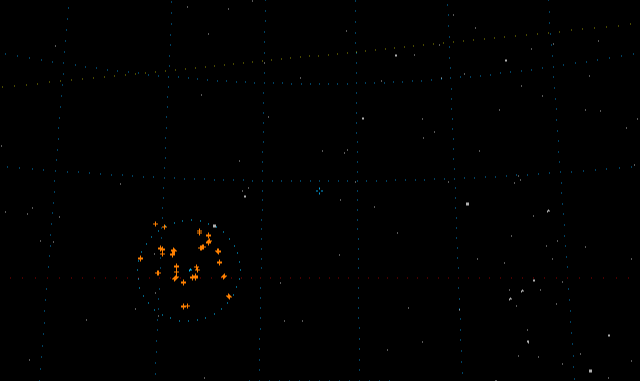 The weather forecast for my location is not hopeful – the standard fodder of clouds and rain. 🙁 Please let us know if you record copious numbers of AMOs on video or DSLR cameras, and if radio observers encounter any increased activity in your detection plots.
The weather forecast for my location is not hopeful – the standard fodder of clouds and rain. 🙁 Please let us know if you record copious numbers of AMOs on video or DSLR cameras, and if radio observers encounter any increased activity in your detection plots.Clear skies,
Alex.
22 November 2019 at 9:58 am #581633 Peter CarsonParticipant
Peter CarsonParticipantA friend and I went to a dark site at 4am for around 70 minutes. The sky was a perfectly clear on our arrival but it soon degenerated into patchy cloud then clouded over completely and started raining about the time of the predicted maximum.
I did see a couple of bright sporadics and one very bright meteor through the clouds that could have been an Alpha Monocerotid, its path was about right but no stars were visible for reference. It must have been bright to have been plainly visible through the clouds.
My meteor camera didn’t pick up anything.
Peter
22 November 2019 at 10:33 am #581634 Bill WardParticipant
Bill WardParticipant… and looking at the RMOB site it looks like my radio system hung yesterday!
also bl**dy typical! ; – ((
22 November 2019 at 11:01 am #581635Colin Briden
ParticipantHello. Using the BRAMS radar in Belgium (49.970MHz) I detected here in York a ninefold increase in rate beginning at 0450 and lasting just a few minutes – ie rate jumped from one event every three minutes to three events a minute. Will post charts and more precise data later today but here are a couple of screen captures
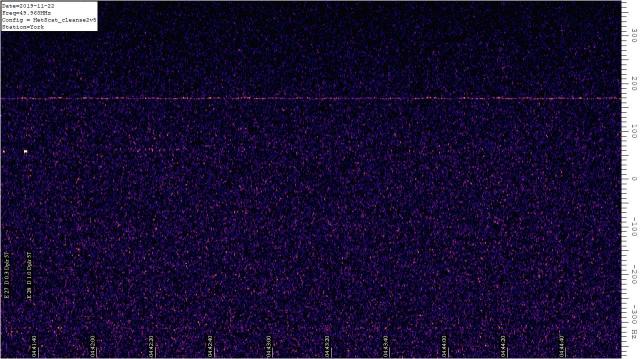
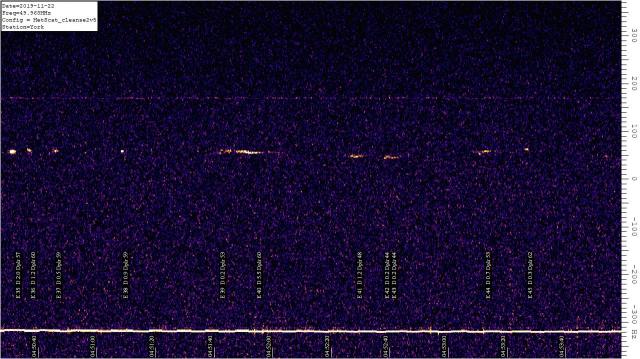 .
.Colin
22 November 2019 at 3:44 pm #581636Colin Briden
ParticipantHistogram of detected
events 0000-0640 – 10m bins. Steady rise to maximum 0450-0500 then rapid fall 0510-0520
Colin
22 November 2019 at 5:02 pm #581637 Alex PrattParticipant
Alex PrattParticipantHi John, Colin,
Nice work.
Your radio detections agree with reports received by the IMO of enhanced rates from around 04:40 to 05:20 UT. Visual observers saw small numbers of AMOs, so this year’s return certainly didn’t produce a meteor storm for us. Valuable data, none the less.
Alex.
22 November 2019 at 9:31 pm #581639Neil Morrison
ParticipantComplete cloud cover here in Crawley W. Sussex
24 November 2019 at 1:11 pm #581640 Derek RobsonParticipant
Derek RobsonParticipantI started watching my meteor radio detector screen from 22/11/2019 04:38 UT. The system uses a 3-element Yagi and Fun Cube Dongle tuned to the Graves radar frequency (my system set at 143.048 MHz). There was a relative increase in activity seen at ~04:39 till ~05:06 UT – definitely a greater rate than 3/hr (the normal visual alpha Monocerotid rate). On average ~10 events/5 minutes (120 events/hour). Signals of longest duration occurred between 04:35 – 04:43 UT [04:35:31, 22.4s, Doppler 43; 04:39:15, 3.6s, Doppler 57; 04:42:46, 12.3s, Doppler 42]. Selection of 5-minute screenshots of radio activity for the time period 04:30 – 05:06 UT. It was raining here in Loughborough, Leicestershire, UK, so no visual meteors to report.
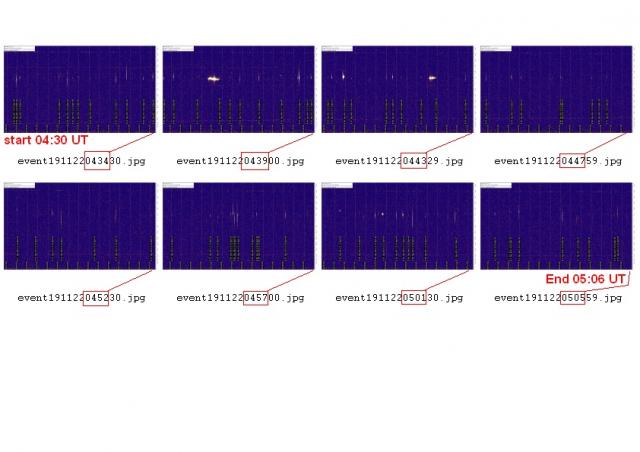
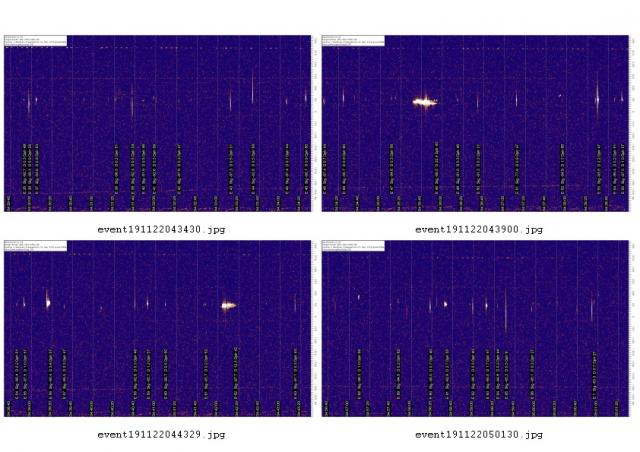
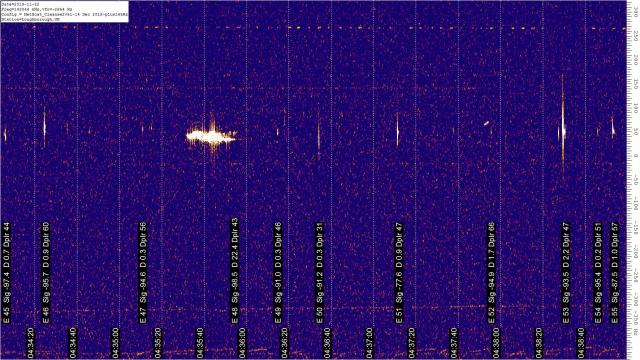 27 November 2019 at 7:30 am #581653
27 November 2019 at 7:30 am #581653John Berman
SpectatorSo I added Derek’s data to mine and we are pretty much in line with the peak ( note that I only capture events that are 2 seconds or longer)
Regards
John B
-
AuthorPosts
- You must be logged in to reply to this topic.
